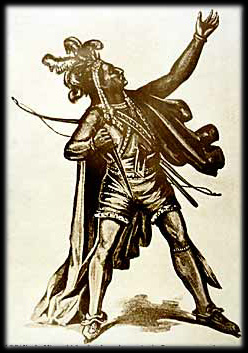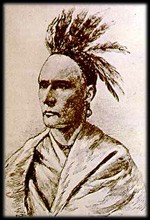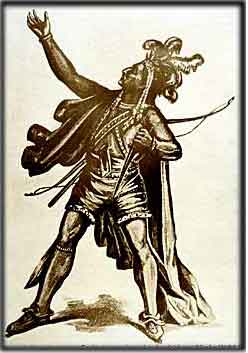 |
and Their Chief Logan Although the Mingo are usually discussed
in association with western Penna and Ohio,
|
 |
 |
and Their Chief Logan Although the Mingo are usually discussed
in association with western Penna and Ohio,
|
 |
| The Mingo [Sometimes
found as the Ohio Seneca Indians] and Their Chief Logan
The Mingos are often found referenced as sent to live among the Delaware to ensure that the Delaware behaved according to Iroquois mandate, and mention of the Mingo is generally found describing a people associated with Ohio to which the Delaware eventually migrated. Mingos are generally found described as a mixed tribe people. "The name [Mingo] comes from 'Minqua,' a Delaware word meaning treacherous used for the Susquehannock and other Iroquian-speaking tribes. The Mingo were groups of independent Iroquois - mixed Seneca and Cayuga hunters with a heavy percentage of descendents of Neutrals, Huron, and Erie who had been adopted by the Iroquois during the 1650s. They settled in Ohio and western Pennsylvania in the early 1700s and formed mixed villages with the Delaware and Shawnee who [displaced by expansion in Pennsylvania's East] arrived later."16 "George Washington's 1753-54 map of Ohio Country shows Mingo Town about 20 miles below present Pittsburgh, about two miles below Logs Town. An anonymous map of the Ohio drawn about 1755 shows the notation at the same location that 'Senecas moved from here last summer'. These two sources will show that the Mingoes were also considered as Senecas. Brown, Lloyd Arnold, EARLY MAPS OF THE OHIO VALLEY, Pittsburgh, University of Pittsburgh Press, 1959" 22 The Seneca were one of the original five tribes of the Six Nations of the Iroquois Confederacy of Upstate New York. |
 |
|
Soyechtowa's
[AKA Chief Shikellamy of the Iroquois Confederacy ] oldest son
was born ca 1725 probably near Lake Cayuga in upstate New York. Shikellamy,
an able diplomat sent by the Onandaga Council during the crucial phase
of increased volatility in the Susquehanna Valley, was sent to assure
the Indians adhered to the desires of the Iroquois
Confederacy and maintained peace with their trading partners, the English.
This was a period of increased movement of many tribes from the south
and through Pennsylvania to the Iroquois capital at Onandaga in New York.
Shikellamy succeeded in helping to shift Pennsylvania Indian policy
to favor the Iroquois over the Lenape/Delaware
. Conrad Weiser , a close friend to the Chief, and Shikellamy paved the
way for the Walking Purchase of 1737 in which the Delaware and Shawnee
lost the last of their eastern Pennsylvania lands, dismantling
the practice of William Penn to treat with "his Indians" -the native Lenni
Lenape [aka Delaware]23. The Iroquois
were willing to conspire with the Penns to remove the Lenape/Delaware ,
for a profit, from their remaining lands . When, in
1728, Shikellamy moved with his family to the Susquehanna Valley,
the region was seeing increased white settlement, was aware of the
anger of Lenape/Delaware and Shawnee
regarding pressures to relinquish their lands, and experienced a
steady stream of southern Indian refugees moving slowly towards
the Iroquois capital, having asked, and recieved , permission from the
confederacy to move through Pennsylvania. Along the way, the refugees
established temporary camps, and both James Logan and Conrad
Weiser understood that the Iroquois were obligated to provide protection
to persons in the confederacy's covenant chain seeking its
protection. "Taking advantage of this situation, and in order to
assure peace between the colonials and the natives, Chief Shikellamy was
appointed by the highest governing body of the Confederacy, the Onandaga
Council, to act with Iroquois authority over the tribes of Pennsylvania.
This official was known among the Delawares as Shikellamy, which is pronounced
ìShi-KELL-a-mee,î and means 'Our Enlightener.î'24
|
Shikellamy , as a Chief of the Iroquois and member of its council, and through the changing Indian policy he encouraged in Conrad Weiser and James Logan of Philadelphia, assured Iroquois control of the land and all the tribes that lived there, including that of the Delaware and Shawnees. and any remnants of the Susquehannocks, now known as Conestogas living in greatly reduced numbers and by then in complete subjuation to the Iroquois for some 30 odd years. "Permission to move, hunt and live within these open spaces by all tribes was at the pleasure of the Six Nations and subject to approval by Iroquois Council through Shikellamy." 21 .By absorbing his father's handling of Indian affairs and by gaining intimacy with the white agents, Chief Logan became a trusted friend of the whites and on moving to Ohio was elected Chief of the Mingo. Chief Logan's younger brother , with whom he is often understandably confused, maintained residency near Harrisburg in 1773.
"The botanist John Bartram described 'Shikellamy's son' as tall and commanding, but in context Bartram seems to have referred to the older brother Tachnechdorus, who had inherited Shickellamy's mantle as Iroquois head man in the province. Nonspecific sources hint that Logan the Mingo was lame. He was certainly not Shickellamy's political successor.
"Brother Tachnechdorus told the Pennsylvania
Council in 1756 that Logan and his family were living near Shamokin and
were in jeopardy from hostile Delawares. The brothers tried to persuade
the Delawares to resume friendship with Pennsylvania but were rebuffed
angrily. Logan was "led astray" by those Delawares, according to his brother,
but repented and desired to rejoin the Pennsylvanians. In August 1762,
he attended the important treaty at Lancaster, but he did not speak. "26
.
" Conrad Weiser records in his journals
that he had little difficulty distinguishing between Shikellamyís sons.
The elder of the two was called Tachnechdours, or John, and the younger
Tahgahjute, or James Logan, so named by his father in honor of the Secretary
of the Provincial Council of Pennsylvania. For the next 15 years, both
sons were generally referred to as the 'Shikellamies,' and it was not until
1765, when they went their separate ways, that white men began to attach
to Johnís name the surname 'Logan,' by mistake. So it was that both brothers
became 'Logan.' Without the name John or James attached to Logan, it became
virtually impossible to tell which Logan was meant when spoken of. .....Following
the death of his father Shikellamy in 1784 [sic ] , conditions on
the Eastern frontier became increasingly ..... difficult for Logan. He
was caught between two worlds. One world included the memory of the great
friendship between [his father] Shikellamy and Conrad Weiser,
Pennsylvaniaís Indian ambassador [and ] the many white men Weiser
brought with him to Shamokin and witnessing their fair treatment of the
Indians... On the other hand, the increasing westward pressure of longhunters,
settlers and land grabbers for more territory in the homeland of the Indians
made Logan very uneasy. Loganís days in the valley of the Susquehanna were
numbered. [See The Settlement of Adams County and regions west of the Susquehanna
discussed in the Adams County Page's Footnote
One: Blunstone Linceses , discussing the Penn agents attempts
to expand beyond negotiated territory and in the region occupied by Shikellamy
and his sons ]
"For the next five years, Logan resided at Loganís Spring in what us now Mifflin County, Pennsylvania.... Logan moved to the Ohio River in spring 1770...readily accepted by his Iroquois neighbors living in the Ohio Valley. These Iroquois, displaced from their ancestral homeland in New York state, were given the name Mingoes by local tradition; thus, Logan received a new name: Logan the Mingo, or Logan, Chief of the Mingoes. And it is at this point, in the summer of 1773, that we get our final real evidence that John and James Logan were living at opposite ends of Pennsylvania. Most early historians had proclaimed James Logan as Chief Logan and placed his home on the Ohio; however, historian Paul A. W. Wallace reports the following information from the Bureau of Land Records in Harrisburg:"21
A warrant issued on September 17, 1773, for George Ballard, describes his tract of 300 acres in these words: " . . . situate on the East side of the North East Branch of Susquehanna about 3 or 4 Miles back of where James Logan was living in the vicinity of his father Shikellamyís old home near Shamokin (now Sunbury, Pennsylvania)." ("Logan the Mingo; A problem in Identification," Repr., Pennsylvania Archeologist Bulletin XXXII, Dec. 1962: 92)"21
An unsuspecting victim of the struggle
over territory with the evacuation of Fort Pitt in 1774 and Lord Dunmore's
War subsequent, Logan lived on the Ohio River near present
Wheeling, West Virginia26 , in close
proximity of the whites, owing to his status as friendly native. Dunmore
hoped to snatch up Shawnee lands, and engaged in propaganda against them,
and numerous homesteaders swarmed into the region, with the same intent
for land acquisition. A large company of seventy to ninety men congregated
at Wheeling and hired veteran frontiersman Michael Cresap as their leader.
26
In 1774, Chief Logan, ever a friend of the white man, returned from a hunting trip to find that his family [including his brother and sister] had been killed by white settlers. Exacting revenge, this once docile friend became a feared enemy. Eventually forced to surrendor, the message he sent to the Whites when they met with his war ally Cornstalk [a Shawnee] was made famous by Thomas Jefferson in his "Notes on the State of Virginia" . War broke out, Chief Logan himself was killed by his people, and The Mingos spread across Ohio- Some Mingo Indians lived with the Miami Indians, while others lived with the Shawnee. In 1831, the United States forced the Mingos to sell their land, and the natives moved to reservations in the West.
Mingo Chief Logan Wrote:
"I appeal to any white man to say if he ever entered Loganís cabin hungry and he gave him not meat; if he ever came cold and naked he clothed him not. During the course of the last long and bloody war, Logan remained idle in his cabin, an advocate for peace. Such was my love for the whites that my countrymen pointed as I passed and said, 'Logan is a friend of the white man.' I had even thought to have lived with you but for the injuries of one man, Colonel Cresap, the late spring, in cold blood and unprovoked, murdered all the relatives of Logan, not even sparing his wives and children. There runs not a drop of my blood in the veins of any living creature. This calls on me for revenge, I have sought it; I have killed many; I have grown glutted in my vengeance. For my country I rejoice at the beams of peace; but do not harbor any thought that mine is the joy of fear. Logan never felt fear. He will not turn his heel to save his life. Who is there to mourn for Logan? Not one. "IroquoisMingoSusquehannocksShawneeLenni Lenape [Delaware] The Natives of Eastern and South Central Pennsylvania: Page Contents
Sources for This Page [annotated from
larger list below] :
16, 21, 22, 23, 24, 25, 26
16. The
Iroquois. by Lee Sultzman. Part of First
Nations Histories
21. Chief
Logan: Friend, Foe or Fiction? by Ronald R. Wenning. The
Journal of the Lycoming County Historical Society, Volume XXXVII, Number
1, Fall, 1997
22. Mingo
Indians part of The Allegheny Regional Family History Society's Web
pages
23. Weiser,
Shikellamy and the Walking Purchase By Al Zagofsky
24. Conrad
Weiser from the Pennsylvania Historical and Museum Commission
25. The
Walking Purchase from Pennsylvania Historical and Museum
Commission
26. James
Logan , Mingo Indian from The American National Biography, published
by Oxford University Press under the auspices
of the American Council of Learned
Societies.
Source List for Subject Title [Natives
of Southeastern and Southcentral Pennsylvania] , all pages
Below is the list of Sources utilized
in all of the Natives of Pennsylvania Subject Title Pages, of which the
numbers above are part.
1. State Museum of Pennsylvania. Brief Summary of the 1681 Charter.
2. York
County History Pages of York
County Webpages.
3. Penn
and the Indians
page of site entitled " William Penn. Visionary Proprietor" by
Tuomi J. Forrest
4 Indians, Sources, Critics by Will J. Alpern (Prudential-Bache Securities). Presented at the 5th Cooper Seminar, James Fenimore Cooper: His Country and His Art at the State University of New York College at Oneonta, July, 1984. ©1985 by State University of New York College at Oneonta ["may be downloaded and reproduced for personal or instructional use, or by libraries" ] Originally published in James Fenimore Cooper: His Country and His Art, Papers from the 1984 Conference at State University of New York College -- Oneonta and Cooperstown. George A. Test, editor. (pp. 25-33)
6. SUSQUEHANNOCK
HISTORYpart of First
Nations, Issues of Conesquence pages. Lee Sultzman
7. SUSQUEHANNOCK
HISTORY, Lee Sultzman. Part
of First
Nations Histories
8.Information
on the Susquehannock Indians from Pagewise
9. Delaware History by Lee Sultzman.. Part of First Nations Histories
10. Where are the Susquehannock now? part of the pages of BrokenClaw.com
12. Native Americans Post Contact:, from The Mariners Museum, Newport News, Va pages
13. . Internet School Library Media Center, Monacan Indians page.
14. AN AMERICAN SYNTHESIS The Sons of St. Tammany or Columbian Order . [ the footnotes evident in the text takent from "an American Synthesis" can be accessed at the link given in source
15. Iroquois . By: Joe Wagner, with references provided.
16. The Iroquois. by Lee Sultzman. Part of First Nations Histories
17 William
Henry Harrison and the West , part of Dr James B. Calvert's pages
at University of Denver Website.
At the time of Penn's arrival in 1682,
the Susquehannock were subservient to the Iroquois Confederacy, just as
their enemies and neighbors, the Delaware , were. The Susquehannock were
decimated by war and disease, but the Lenape remained vital.
18. Shawnee's Reservation a detailed site on Shawnee History
19. Shawnee History by Lee Sultzman. . Part of First Nations Histories
20. Marjorie Hudson, Among the Tuscarora: The Strange and Mysterious Death of John Lawson, Gentleman, Explorer, and Writer, North Carolina Literary Review, 1992 [transcribed at East North Carolina Digital History Exhibits]
21. Chief Logan: Friend, Foe or Fiction? by Ronald R. Wenning. The Journal of the Lycoming County Historical Society, Volume XXXVII, Number 1, Fall, 1997
22. Mingo Indians part of The Allegheny Regional Family History Society's Web pages
23. Weiser,
Shikellamy and the Walking Purchase By Al Zagofsky
24. Conrad Weiser from the Pennsylvania Historical and Museum Commission
25. The Walking Purchase from Pennsylvania Historical and Museum Commission
26. James
Logan , Mingo Indian from The American National Biography, published
by Oxford University Press under the auspices
of the American Council of Learned
Societies.
27. The
Lineage of Mother Bedford from Mother
Bedford , a website devoted primarily to the history of Old-Bedford
County, Pennsylvania during the American Revolutionary War period.
28. Year
1736. part of the webpage entitled "Ben Franklin :A Documentary
History" by J A Leo Lemay , English Department , Professor University
of Delaware, Newark, Delaware.
29. Shawnee'
entry from Hodge's Handbook Abstract: The 'Shawnee' entry from Handbook
of American Indians North of Mexico, edited by Frederick
Webb Hodge (Smithsonian Institution, Bureau of American Ethnology Bulletin
30. GPO: 1910.)
30. sample
chapter of At
the Crossroads Indians and Empires on a Mid-Atlantic Frontier, 1700-1763
by Jane T. Merritt [book content , availability
and sample chapter viewable and obtained via The
University of North Carolina Press]
and
(New Jersey) Extract from The Indian
Tribes of North America by John R. Swanton. Bureau of American
Ethnology Bulletin 145ó1953. [726 pagesóSmithsonian Institution] (pp. 48-55).
Presented in pages of
the
Northern Plains Archive Project web site.
|
To Our American Immigrants To Our Pennsylvanians -See Pennsylvania Index |
 |
Email Webmistress |